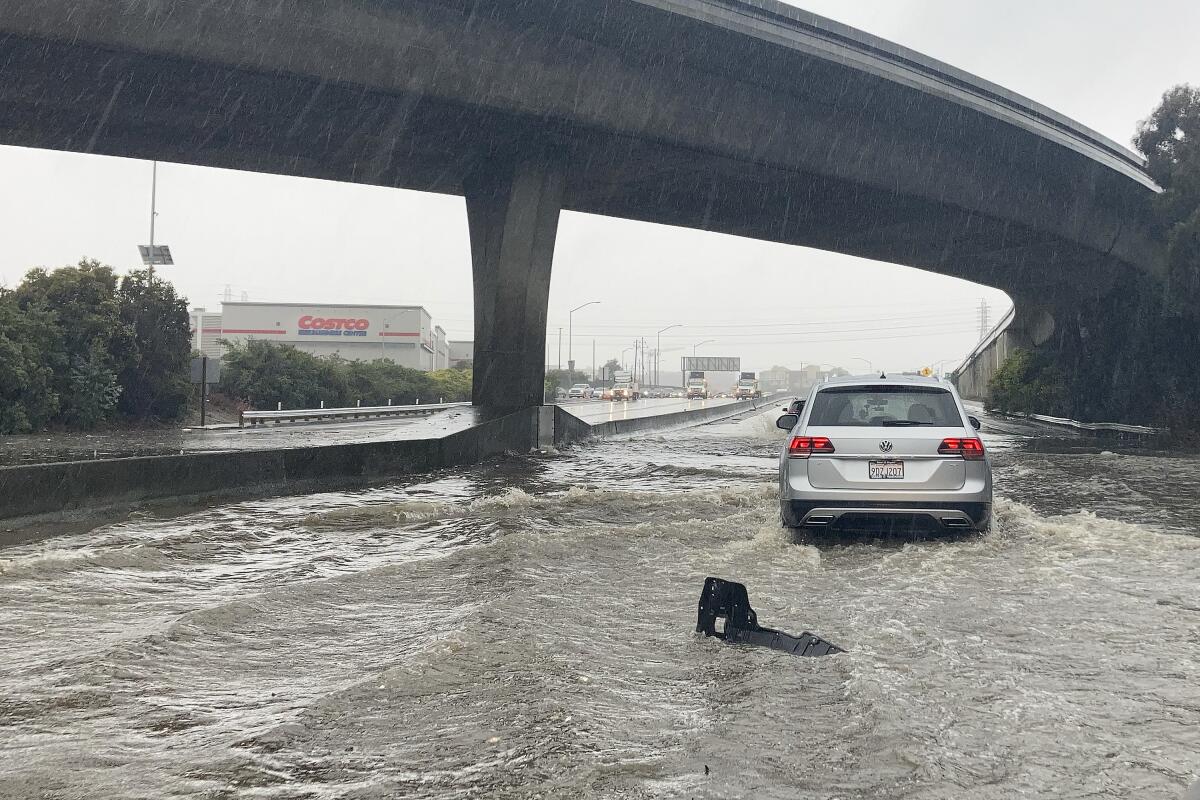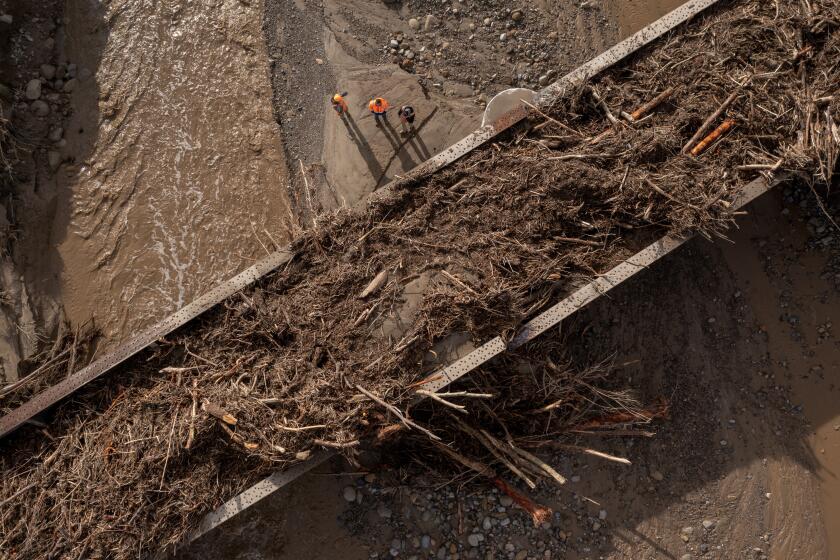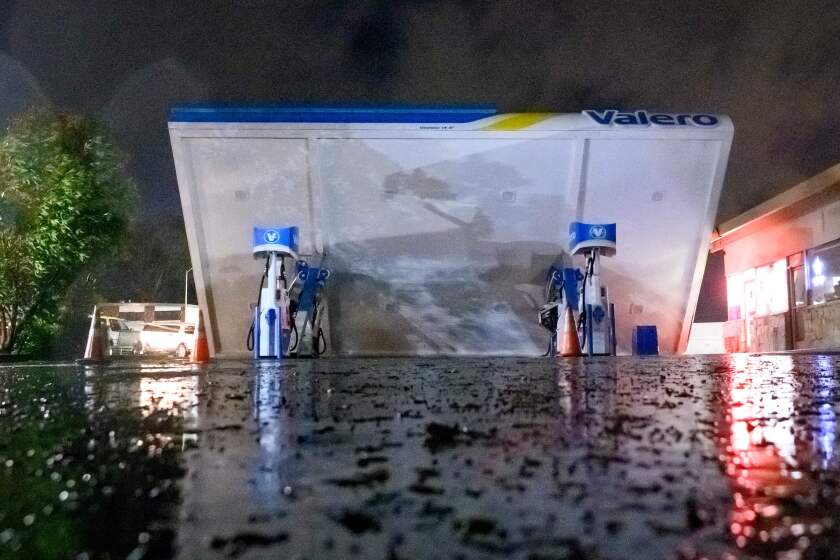How to prepare and pack if you might need to evacuate

- Share via
If you receive an evacuation order, it’s time to go.
Portions of northern Santa Cruz County and southern San Mateo County were put under an evacuation warning this week as the atmospheric river slammed into the state, dumping rain on burn-scarred areas prone to flooding and mudslides. Part of the city of Watsonville was ordered to evacuate Tuesday night.
L.A. County said residents who live near the Lake and Bobcat fire areas should “be ready” for possible evacuations beginning Wednesday afternoon.
Even if you’re not in a generally flood-prone area, with this storm, “everyone should be prepared,” said Bryan La Sota, a coordinator for L.A. County’s Emergency Management Department. Years of drought and devastating wildfires have left many parts of the state prone to erosion and debris flows. Already, the storm has led to flooding, road closures and power outages around the state.
The more time you have to prepare and pack, the better off you’ll be if you receive an evacuation order. Sign up for your city or county’s alert system to get updates about possible and mandatory evacuations. In the city of L.A., that’s Notify L.A. For other parts of L.A. County, find your municipality’s alert system sign-up here. Outside of L.A. County, search “emergency alerts (your city or county).”
While the rain is coming down, it’s generally safest to stay at home. But you should be ready to leave if you’re ordered to. Here’s how to prepare and what to pack if you might need to evacuate.
The powerful storm that knocked out power, toppled trees — including one that killed a toddler — and flooded homes along the coast in Santa Cruz continued its march through the region.
What’s the difference between an evacuation warning and an evacuation order?
An evacuation warning means there is a potential threat to life and/or property, and your area might be ordered to evacuate at some point. If you will require extra time to evacuate — for instance, if you have very young or old family members, or people who use medical or mobility devices that may take a long time to get out of a house and into a vehicle — you should consider evacuating under a warning.
An evacuation order means there is immediate threat to life and/or property. It is a legal order requiring everyone to evacuate their homes immediately.
What to pack for an evacuation
Your go bag. Put together a backpack or other sturdy bag with emergency kit essentials. Here’s a full list of what should be in your emergency kit. The short version: A first aid kit, flashlights and batteries, enough water and nonperishable food for a couple of days (and utensils and can openers as needed), chargers for your devices, several days’ worth of clothing, blankets and sleeping bags, a fire extinguisher, garbage bags, toilet paper, moist towelettes, hand sanitizer, face masks, a whistle to signal for help, items to help you pass the time (say, books and board games), and a paper map of your area in case you can’t access GPS service or need to find an alternate route around closed roads.
In addition to your go bag, you want what emergency management professionals refer to as the “6 Ps.”
People and pets. Every living creature in your home.
Papers and phone numbers. “Papers” means vital identifying documents like your family’s birth certificates, Social Security cards, passports, vaccination cards and insurance information. You will also want to write down a list of important phone numbers in case your phone battery dies while you’re evacuating and you can’t access your contacts. That list should include family members, friends, a boss or coworker, doctors, veterinarian, pediatrician, lawyer, insurance agent, landlord or building manager, and the phone number for the destination you’re heading to, like a hotel or relative’s home.
Prescriptions. This is shorthand for any medical items you or a family member might need. That includes prescription medications, eyeglasses or contact lenses and contact solution, toothbrushes and toothpaste, and feminine hygiene items. If you’re evacuating with someone who wears diapers, make sure you have plenty of those. You should also have a first-aid kit in your go bag that contains bandages and gauze, antibiotic cream, antacids, medical tape, anti-diarrhea medications, antihistamines and over-the-counter pain relievers.
Pictures and personal items. Anything you couldn’t replace or bear to lose should come with you, as long as it fits in your car and won’t delay your evacuation. Photo albums, heirlooms, musical instruments, plants, jewelry and video game consoles all fall into this category.
Personal computers. Make sure your laptop is charged and packed up. If you use a desktop computer, consider making a copy of vital documents on a thumb drive if you have time.
Plastics. Your identifying information, including IDs, credit and debit cards, and cash.
The intense downpours — coming after an earlier deluge days ago — pushed some rivers toward flood stage, prompting a string of evacuations from towns along the Russian River to communities in Santa Cruz County and beyond.
What to do when you’re ordered to evacuate
Wear sturdy shoes. Don’t leave your house in slip-ons or flip-flops: Dress like you might need to leave the car in bad weather. Your ankles should be secure and your toes should be covered.
Leave as quickly as possible. Evacuating ASAP will help keep roads clear for emergency workers.
Heed road closures and don’t drive on flooded streets. “Turn around, don’t drown” is the guidance for waterlogged roadways. As little as six inches of water can cause stalling and loss of control in a passenger car, and just two feet can sweep vehicles off the road, including pickups and SUVs. Stay safe and find an alternate route.
About The Times Utility Journalism Team
This article is from The Times’ Utility Journalism Team. Our mission is to be essential to the lives of Southern Californians by publishing information that solves problems, answers questions and helps with decision making. We serve audiences in and around Los Angeles — including current Times subscribers and diverse communities that haven’t historically had their needs met by our coverage.
How can we be useful to you and your community? Email utility (at) latimes.com or one of our journalists: Jon Healey, Ada Tseng, Jessica Roy and Karen Garcia.
More to Read
Sign up for Essential California
The most important California stories and recommendations in your inbox every morning.
You may occasionally receive promotional content from the Los Angeles Times.
















